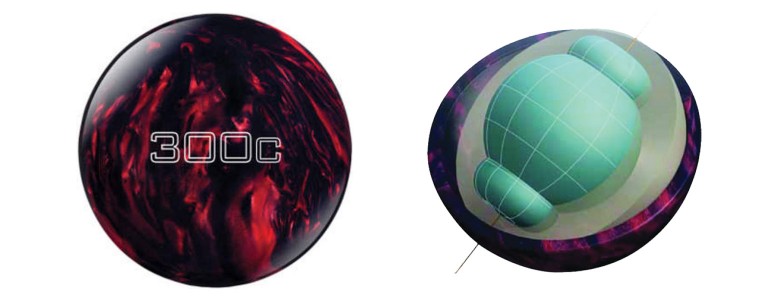General Info
| Brand: | Track |
| Name: | 300C |
| Reviewed: | August 2010 |
| Empty | |
| Coverstock Specs | |
|---|---|
| Name: | LMP Gen-1 Reactive w/Performance Pearl Additive |
| Type: | Reactive Pearl |
| Box Finish: | 500 / 1000 / 2000 / 4000 Abralon / Powerhouse Factory Finish Polish |
| Color: | Black / Red Pearl |
| Empty | |
| Core Specs | |
| Name: | Track Symmetric |
| Type: | Symmetrical |
| RG: | 2.55 |
| Diff: | 0.025 |
| Int. Diff: | 0.000 |
For details on our standard test layouts, please click here.
The 300C starts a new performance category for Track. By now we should all know that the name of the ball gives us the performance level and shape of the hook. This is the first time Track has used a symmetrical core in a bowling ball since the move to Hopkinsville. When testing dry lane equipment, we usually find a weak core ball with a stronger shell or a stronger core with a weaker cover. While these combinations produce balls that are smoother rolling, making them very controllable, they seldom work well on true dry lane conditions. Track has solved this equation by combining the forces of a weaker cover and weaker core, thus successfully producing their first true dry lane ball in quite some time, probably since the Desert Heat.
It is no surprise that all three testers found their best reactions on our dry test pattern. On this short, low volume pattern, our testers were able to play a straighter line to the breakpoint than they are used to on this pattern. The controlled nature of the 300C gave us a pinch of hold area we very seldom experience on this pattern. That extra bit of hold allowed all three testers to loosen up their armswings, which is always a plus.
Those with medium to high rev rates will find the 300C to be useful on some medium patterns as well. Those with lower rev rates can alter the surface, if necessary, to find the appropriate amount of friction for this pattern. Those trying to use this ball on longer oil patterns are simply asking for trouble. There are plenty of better choices from Track for that type of condition.
This ball will perform best on medium-light and light oil sport patterns. Ours is on the medium side and each tester was able to find a line to the pocket, although the entry angle just wasn’t right. This is a ball you would pull out after several games have been bowled with more aggressive equipment creating a more favorable condition.
Strengths
The combination of the weak reactive pearl cover wrapped around a symmetrical core will allow bowlers of all styles to combat dry lane patterns. Patterns that start with a low volume of oil or patterns that break down are where the 300C will be the most useful tool in a bowler’s hands.
Weaknesses
There is no doubt that the 300C is perfect for drier lane conditions. It will struggle in larger volumes of oil. This core/cover combination is designed to create less friction, not more.
Overall Summary
The 300C gives Track fans their first true dry lane option in a very long time. The low friction cover combined with the low differential core provides superb predictability and control for the 300C. This makes it an easy decision for players looking for a ball to be able to use on lighter oil patterns.
Track 300C Comparisons
Click below to see a comparison table of each pair of bowling balls shown:
- Track 300C vs. Track 300A
- Track 300C vs. Track 300C Solid
- Track 300C vs. Track 300T
- Track 300C vs. Track 400A Special Edition
- Track 300C vs. Track 503C
To compare the Track 300C to any other bowling ball(s), please use our Bowling Ball Comparison tool.

